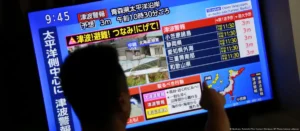A powerful magnitude 8.8 earthquake off the coast of Russia’s Kamchatka Peninsula has prompted tsunami warnings in both Japan and the United States. Russian officials reported that it was the strongest quake to hit the region in decades.
A powerful earthquake struck off the coast of Russia’s Kamchatka Peninsula in the far east on Wednesday morning, prompting tsunami warnings in Japan and the U.S. state of Hawaii.
According to the United States Geological Survey (USGS), the magnitude 8.8 quake occurred at a shallow depth of 19.3 kilometers (12 miles).
Japan’s Meteorological Agency (JMA) issued a tsunami warning, cautioning that waves as high as 3 meters (nearly 10 feet) could impact the country’s eastern and northeastern coastal areas.
“A tsunami advisory was issued at 08:37 (2337 GMT) on July 30,” the JMA announced on X, adding, “Tsunamis may strike repeatedly. Avoid the sea and do not approach the coast until the warning is lifted.”
In a separate message, the agency urged, “Tsunami waves are approaching the coasts. Evacuate as quickly as possible.”
Sergei Lebedev, Kamchatka’s regional emergency minister, reported tsunami waves between 3 to 4 meters were observed in parts of the region and advised residents to move away from coastal areas.
Tsunami waves have begun reaching the shores of Russia’s Kuril Islands and Japan’s northern island of Hokkaido, according to officials.
Valery Limarenko, the local governor, confirmed that the first wave hit Severo-Kurilsk, the main town on the Pacific archipelago. Russian authorities reported that around 2,000 residents were evacuated and advised to stay on elevated ground until the risk of additional waves subsides.
Japan’s Meteorological Agency (JMA) reported detecting tsunami waves up to 40 centimeters (1.3 feet) at 16 different locations, as the waves moved south along the Pacific coast from Hokkaido to areas just northeast of Tokyo.
Officials have warned that larger waves may still follow. The JMA noted that the threat of a major tsunami could persist for over a day following Wednesday’s powerful earthquake.
Tsunami warnings have been issued across the Pacific following the powerful earthquake off Russia’s eastern coast.
In Hawaii, authorities have urged residents to evacuate coastal areas, warning of potentially “destructive” waves. Honolulu officials stressed the importance of moving to higher ground immediately.
In the United States, California issued a tsunami watch for parts of its central coastline, including San Francisco, while a lower-level tsunami advisory has been put in place for the entire U.S. Pacific coast.
Peru’s navy also issued a tsunami warning, stating that the National Tsunami Warning Center had activated an alert for the Peruvian coastline. “The event will be continuously monitored,” the Directorate of Hydrography and Navigation announced on X.
The U.S. Pacific Tsunami Warning Center further warned that tsunami waves could also impact the coasts of Ecuador and Chile along South America’s western seaboard.
The earthquake occurred around 250 kilometers (160 miles) from Hokkaido, Japan’s northernmost main island, according to Japanese public broadcaster NHK.
Kamchatka Governor Vladimir Solodov described the quake as “serious and the strongest in decades” in a video message shared on Telegram. While no major injuries were reported, he noted that a kindergarten building had been damaged.
On Sakhalin Island, located across the Sea of Okhotsk from Kamchatka, authorities ordered the evacuation of the town of Severo-Kurilsk.
Kamchatka, Russia’s Far East, and Japan are located along the Pacific Ring of Fire, a geologically active zone known for frequent earthquakes and volcanic eruptions.
For reference, a magnitude-9 earthquake struck off Japan’s coast in March 2011, triggering a devastating tsunami and a nuclear disaster at the Fukushima power plant.
Following Wednesday’s quake, Japan’s Cabinet Secretary Yoshimasa Hayashi confirmed that no irregularities were found at the facility. However, the Tokyo Electric Power Company (TEPCO) reported that workers at the plant were evacuated as a precaution.